There are many systems of classifications for Gymnosperms in the literature. In the previous post, we discussed the Chamberlain’s System of Classification of Gymnosperms. In this post, we discuss the Sporne’s System of Classification of Gymnosperms (1965). We will also discuss the characteristics of different Classes and Orders in the classification very briefly. You can download the PDF of this article, link given at the end.
Classification of Gymnosperms
Sporne’s System of Classification (1965)
Ø Published by K.R. Sporne in 1965
Ø The entire gymnosperms were divided into THREE classes
- Cycadopsida
- Coniferopsida
- Gnetopsisa
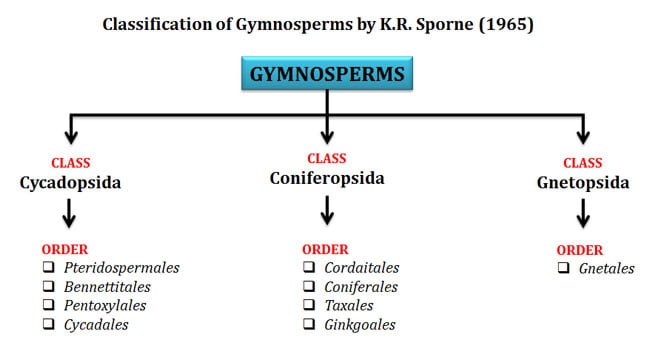
Class I : Cycadopsida
Ø Class Cycadopsida includes fossil and living forms.
Ø The stem is unbranched and stumpy.
Ø Large and pinnately compound leaves.
Ø The male cones are large and compact with simple microsporophylls.
Ø Female cones are loose or pinnate (leaf-like).
Ø Megasporophyll is simple and the ovules are large.
Ø Anatomically the stem is with wide cortex.
Ø The wood manoxylic type (with a large amount of parenchyma)
Ø Class Cycadopsida consists of FOUR orders:
(a). Pteridospermales
(b). Bennettitales
(c). Pentoxylales
(d). Cycadales
(I.a). Pteridospermales
Ø Ptridospermales are also called as cycadofilicales.
Ø They are cycad-ferns.
Ø All are extinct forms (no living representative)
Ø They appeared in the Devonian period and abundant in the Carboniferous period.
Ø The morphology and anatomy of Pteridospermales were similar to that of Ferns and Gymnosperms.
Ø Cones are NOT produced by this group.
Ø Ovules are directly borne on the leaf margin.
Ø Example: Lyginopteris
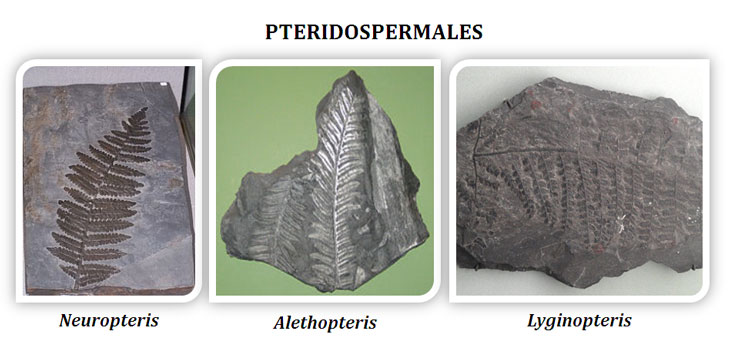
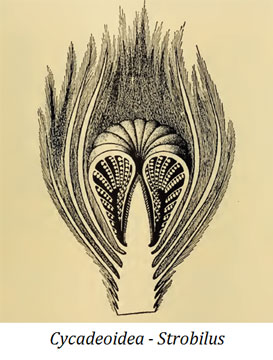
(I. b). Bennettitales
Ø Bennettitales are also called as Cycadeoidales.
Ø They are also an extinct group.
Ø Appeared in the Triassic period, Common gymnosperm of the Mesozoic era.
Ø Completely extinct in the Cretaceous period.
Ø Plant body resembles that of living cycads.
Ø Have stout or slender stem.
Ø Reproductive parts were flower-like.
Ø Cones bisporangiate or monosporangiate
Ø Example: Cycadeoidea, Williamsonia
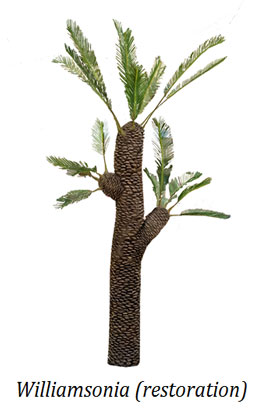
(I. c). Pentoxylales
Ø A completely extinct group.
Ø Plants were shrubby.
Ø Stem with five vascular strands.
Ø Each vascular strand with own cambial ring and undergo secondary thickening.
Ø This group was originally described by Prof. Birbal Sahni (Father of Indian Paleobotany)
Ø Female ‘inflorescence’ with many cones.
Ø Male structures are developed directly on dwarf shoots
Ø Example: Pentoxylon, Sahnia
(I. d). Cycadales
Ø They are the living (present-day) Cycadophyta.
Ø Most of them are xerophytic in nature.
Ø The plant body is palm-like and very slow-growing.
Ø Stem short, un-branched (usually) covered with persistent leaf scars.
Ø Leaves pinnately compound, arranged as a terminal crown.
Ø Leaves show circinate vernation.
Ø All Cycads are dioecious (male and female plants are separate)
Ø Ovules are straight (anatropous).
Ø Example: Cycas, Zamia, Dioon
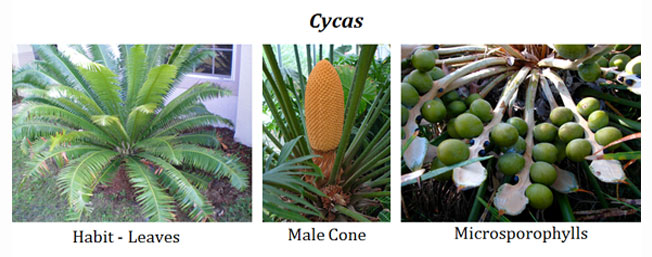
Class II: Coniferopsida
Ø Members of Conferopsida are large, profusely branched tree forms.
Ø Plants with cone-like appearance.
| You may also like NOTES in... | ||
|---|---|---|
| BOTANY | BIOCHEMISTRY | MOL. BIOLOGY |
| ZOOLOGY | MICROBIOLOGY | BIOSTATISTICS |
| ECOLOGY | IMMUNOLOGY | BIOTECHNOLOGY |
| GENETICS | EMBRYOLOGY | PHYSIOLOGY |
| EVOLUTION | BIOPHYSICS | BIOINFORMATICS |
Ø Leaves are simple
Ø Anatomically the pith is small.
Ø Xylem dense and massive.
Ø The wood is pycnoxylic type.
Ø Male and female strobili compact and contain complex sporophylls.
Ø Class Coniferopsida consist of FOUR orders.
(a). Cordaitales
(b). Coniferales
(c). Taxales
(d). Ginkgoales
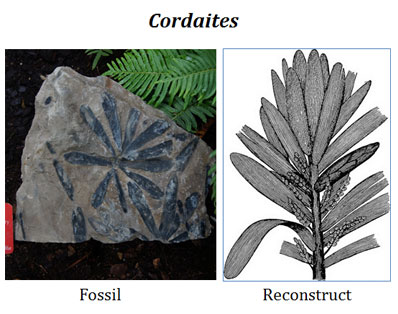 (II. a). Cordaitales
(II. a). Cordaitales
Ø They are the early conifers.
Ø Appeared during the Carboniferous period.
Ø All are extinct, no living representatives.
Ø The plants were tall trees with star-shaped leaves.
Ø The reproductive structures were catkin-like clusters.
Ø Example: Cordaites, Mesoxylon
(II. b). Coniferales
Ø Mostly evergreen trees.
Ø Coniferales represent the largest Gymnosperm order (living forms).
Ø Plants possess xerophyte adaptations.
Ø Leaves usually needle-like and spirally arranged.
Ø Wood with a large number of resin canals.
Ø Plants monoecious or dioecious.
Ø Pollination by wind.
Ø Example: Pinus

(II. b). Ginkgoales
Ø Consists of only one extant genus with one species: Ginkgo biloba
Ø Ginkgo biloba – maidenhair tree.
Ø Ginkgo bioloba is a living fossil.
Ø The plant is native to China (Endemic to China).
Ø Leaves are broad, bi-lobed with dichotomous veining.
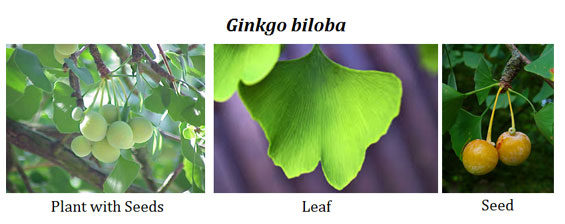
(II. c). Taxales
Ø Members of Taxales are evergreen small trees or shrubs.
Ø An extensively branched plant.
Ø Leaves simple, solitary, flat and distichous.
Ø Leaf arrangement is spiral.
Ø Secondary wood is picnoxylic.
Ø Ovules are surrounded by arils
Ø Example: Taxus
Class III: Gnetopsida
Ø Shrubs or woody climbers.
Ø Morphologically similar to Angiosperms.
Ø Leaves are opposite.
Ø Gnetales are the only gymnosperm having wood with VESSELS.
Ø Embryo dicotyledonous.
Ø Resin canals are absent.
Ø A connecting link between Gymnosperms and Angiosperms.
Ø Contain only one order: Gnetales
Ø Example: Gnetum, Ephedra, Welwitschia
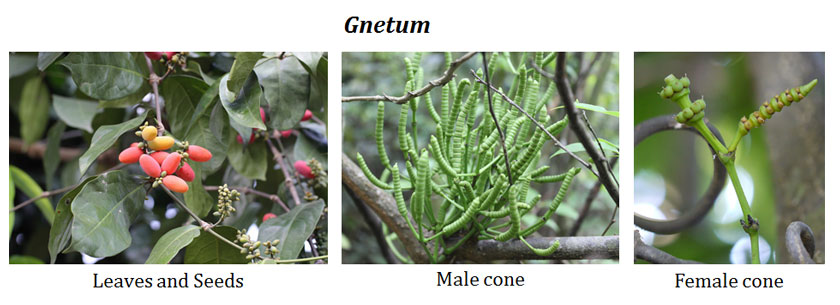
| You may also like... | ||
|---|---|---|
| NOTES | QUESTION BANK | COMPETITIVE EXAMS. |
| PPTs | UNIVERSITY EXAMS | DIFFERENCE BETWEEN.. |
| MCQs | PLUS ONE BIOLOGY | NEWS & JOBS |
| MOCK TESTS | PLUS TWO BIOLOGY | PRACTICAL |
You might also like…
@. Classification of Gymnosperm PDF
@. Gymnosperms General Characters
@. Gymnosperms: Classification by Chamberlain System
@. Gymnosperms vs Pteridophytes

tnx for more contribution & i will always try to be with ur site